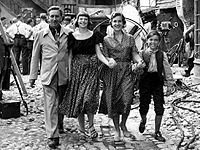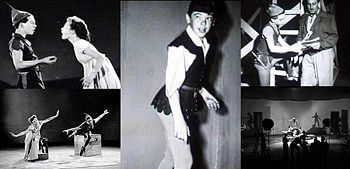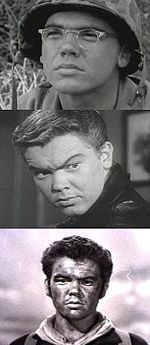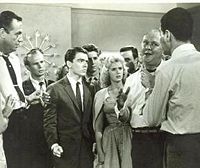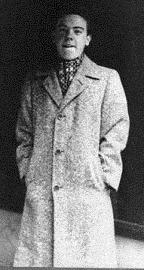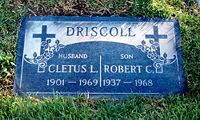Bobby Driscoll
Bobby Driscoll (March 3, 1937 – March 30, 1968) was an Academy Award-winning American child actor known for a large body of screen- and TV-work from 1943 to 1960. He starred in some of the Walt Disney Company's most popular live-action pictures, such as Song of the South (1946), So Dear to My Heart (1948), and Treasure Island (1950), and he was also the close-up model and the voice of the animated Peter Pan (1953).
In 1950, he was the ninth of only twelve children in Hollywood's history to receive an Academy Juvenile Award for outstanding performance in feature films. This category began in 1934 with Shirley Temple and ended in 1961 with Hayley Mills.
Shortly after the theatrical release of Peter Pan, Driscoll's final long-term contract with the Disney Studios was prematurely terminated, officially because of a severe acne he additionally developed at about the same time. That caused an increasing indifference of the Hollywood studios, especially, the older he got. Thus, in his early post-Disney years, he was basically known to a nationwide audience for his continuous work in many American television-series, -dramas and -anthologies, such as Dragnet, Medic, and Climax!, as well as Fireside Theatre, Schlitz Playhouse of Stars, and TV Reader's Digest. However, his screen career ended in 1958 with a final, low-budget teenager-movie, while his TV presence continued until 1960.
In the mid-1950s he became addicted to drugs and frequently fell foul of the law, resulting in continuous withdrawals of acting offers. Despite a hasty marriage in early 1957 and following three children he was unable to kick the habit, what would result in a divorce three years later and an eventual sentencing in 1961. After his release in early 1962 he continued working in common jobs and rejoined the Los Angeles art circle of impressionist Wallace Berman, whom he already befriended in 1956. After his parole had expired in 1964 he moved to New York City and spent a few years as a part of the local avant-garde (also known as the Beat generation) under the tutelage of pop-art icon Andy Warhol. However, in the end his funds depleted and disillusioned he died homeless and penniless in an abandoned Manhattan tenement in March of 1968 at the age of 31 due to the effects of his long-time drug abuse.
Life and career
Birth and early childhood
Born Robert Cletus Driscoll in Cedar Rapids, Iowa, Driscoll was the only child of Cletus Driscoll, an insulation salesman, and Isabelle Krantz Driscoll, a former schoolteacher. Just months after his birth, the family moved to Des Moines,[1] where they stayed until early 1943. When a doctor advised the father to relocate to balmy California (U.S. state), due to pulmonic ailments he suffered from his work-related handling with asbestos, the family moved to the vicinity of Los Angeles. Driscoll was discovered during a routine haircut a few months later when the barber, attracted by the boy's cute face, urged his parents to try to get him into the movies. His own son, an occasional actor, did then indeed manage to gain him an audition at MGM for a bit role in the 1943 family drama Lost Angel, which starred up-and-coming Margaret O'Brien.
While on a tour across the studio lot, the five year old Driscoll spied a mock-up ship and asked where the water was. The director was impressed by the boy's curiosity and intelligence, and selected from forty applicants, he won the part. [2][3]
The "Wonder Child"

Driscoll was so convincing in his brief, scarcely two minutes debut,[4] that 20th Century Fox hired him out of a crowd of 500 children for the role of young Al Sullivan, the youngest of the five historic Sullivan brothers, in the 1944 World War II drama The Fighting Sullivans opposite Thomas Mitchell and Anne Baxter. Because of the naturalness of his acting and his uncommon talent for memorizing lines at that young age, he was soon considered a new "Wonder Child",[5] and one major studio would recommend him to another, leading to screen portrayals as the boy who could blow his whistle while standing on his head in Sunday Dinner for a Soldier (1944), the "child brother" of Richard Arlen in The Big Bonanza (1944) and young Percy Maxim in So Goes My Love (1946),[6] with Don Ameche and Myrna Loy. In addition, he had a number of smaller roles in movies like Identity Unknown, in 1945, and Mrs Susie Slagel's, From This Day Forward, and O.S.S. with Alan Ladd, all three of which were released in 1946.
Walt Disney's "Golden Boy"
Song of the South
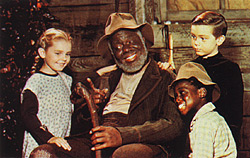
Walt Disney himself cast and contracted Driscoll as his first ever live actor for the lead character in Song of the South, 1946, which was his first serious attempt to turn away from pure feature-length animation pictures, which, in the past, often proved losses rather than profits. [7] In addition, Disney considered live action pictures much cheaper and faster to produce than animated ones. Yet, the film still consists of mostly cartoon segments rather than of live action. Nevertheless, almost overnight Song of the South made Driscoll and his little co-star Luana Patten the new child stars of their days. Both were even discussed for a special Academy Award as the best child actors of 1946, but in 1947 it was decided not to present any juvenile awards at all.[8] However, in 1948, James Baskett, who died just months after the ceremony, won an Honorary Oscar for his performance as Uncle Remus and as the voice of Br'er Fox.
So Dear to My Heart
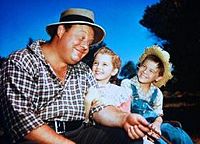
Now nicknamed by the American press as Walt Disney's "Sweetheart Team",[9] the children had another big movie hit together with So Dear to My Heart, 1948, opposite acting balladeer Burl Ives and veteran character actress Beulah Bondi. It was planned as Walt Disney's first all live-action movie, and production in fact began immediately after Song of the South. [10] However, its release was postponed until late 1948 to allow the addition of animated scenes to meet the demands of Disney's co-producer and long-time distributor RKO Radio Pictures, since in 1947/48 they considered it still unimaginable for a Disney picture to be entirely without animation.
The Window
This movie and the RKO production The Window (1949),[11] (which became the "sleeper" of the year), based on Cornell Woolrich's 1947 crime classic The Boy Who Cried Murder, would earn Driscoll a special Academy Award in March 1950 as the outstanding juvenile actor of the year 1949.[12][13]
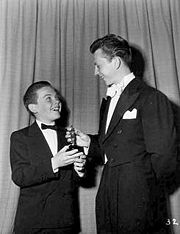
Large portions of this low budget film noir were shot between November and December 1947 in RKO-Pathé's newly constructed studios in (East) Harlem, New York City and in abandoned tenements on 105th and 116th Streets.[14] [15] In mid-December 1947 then the production moved back to Los Angeles, where, in early 1948, interior scenes were filmed. [16][17][18] But the finished picture was shelved because Hollywood producer Howard Hughes, who bought the RKO studios the previous year, considered it unworthy of release and even the boy not much of an actor. Not until studio authorities were able to convince him that it would make more sense to give it a try, seeing that it was already completed and paid for, did The Window have a belated premier in May 1949. Driscoll's haunting performance of a little blowhard, whom nobody wants to believe to have witnessed a real murder became the surprise hit of the year, and recouped a multiple of its production costs.
The New York Times reviewed it: "[...]The striking force and terrifying impact of this RKO melodram is chiefly due to Bobby's brilliant acting, for the whole effect would have been lost were there any suspicion of doubt about the credibility of this pivotal character.[...] "The Window" is Bobby Driscoll's picture, make no mistake about it.[...] [19]
If You Knew Susie and Melody Time
Prior to shooting The Window, Driscoll played Eddie Cantor's screen son in the 1948 RKO musical comedy If You Knew Susie, in which he teamed up with former Our Gang member Margaret Kerry.[20] She would work with him again just a few years later in Walt Disney's 1953 animated Peter Pan - he as the close-up model and the voice of the title character and she as his pixie girlfriend Tinker Bell.[21] In addition, once again along with his child partner Luana Patten, Roy Rogers and The Sons Of The Pioneers, he appeared in the teaser of the Pecos Bill segment of Disney's cartoon compilation Melody Time, which was released in 1948.[22]
Treasure Island
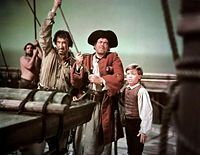
Driscoll's portrayal of Jim Hawkins in Walt Disney's version of Robert Louis Stevenson's Treasure Island at the side of British actor Robert Newton as one-legged Long John Silver, earned him his star at 1560 Vine Street on the Hollywood Walk Of Fame,
Treasure Island was Walt Disney's eagerly awaited first all live-action picture. Both Disney and RKO had huge amounts of pre-war money frozen in the United Kingdom, which, according to the law of the land, could only be spent there. Therefore, it was a matter of fiscal necessity to film the movie in England rather than in Hollywood. [23] But during production, it was discovered that his young star was not in possession of a valid British work permit, and as a consequence, he, his parents and Walt Disney himself were fined and even ordered to leave the country. When the Driscolls were granted permission to remain for six weeks to prepare an appeal, Disney and director Byron Haskin immediately spirited the boy away to a sound stage where they shot all of his close-ups,[24] while they used his British stand-in to film still missing location scenes after he and his parents had returned to California. [25]
In the aftermath of this international box office hit, there were several other film projects involving Driscoll under discussion. But none ever materialized. That's why many of his ensuing performances were confined to television and radio. For example, Byron Haskin recalled in his memoirs that Disney, although interested in Robert Louis Stevenson's pirate story as a full length cartoon, always planned to cast the boy as Mark Twain’s Tom Sawyer. [26]At that point in time, he was at the perfect age for the role, but because of a story rights ownership dispute with Hollywood producer David O. Selznick, who had previously produced the property in 1938 with Tommy Kelly as the title character, Disney ultimately had to cancel the entire project..
On June 7, 1950 the Los Angeles Times wrote: "Walt Disney would like to star Bobby Driscoll in Tom Sawyer, but David O. Selznick has the property tied up and heaven only knows what he wants for it."[27]
According to Haskin's memories: "[...] there was an agreement among major producers for story material in public domain. If a company was first in line with a claim, they were given priority. Each year they must maintain a certain amount of expense for story development, securing the rights. [...] Walt had always wanted Tom Sawyer in the worst way. David O. Selznick had prior rights as producer for MGM, and MGM had also the rights to Treasure Island, [...]. Walt put in a kind of shotgun claim for all material not claimed, or delinquent. MGM carefully maintained rights to Tom Sawyer, but one year they slipped and didn’t develop Treasure Island."[28]
That's how Disney became its possessor and Treasure Island one of his most famous classics, - instead of Tom Sawyer, whose follow-up story he produced in 1960 as The Adventures of Huckleberry Finn with teenage singer Eddie Hodges in the title role.
Haskin also cited Disney with the words: "[...] I want Tom Saywer, not Treasure Island."[29]
So they threw it in the "vault", where it was found by screenwriter and professor of English Larry W. Watkin, who also wrote the novel of the famous stage play On Borrowed Time, just a few years later. His sixty pages treatment eventually gave Disney the idea of the story as a cartoon, and only Great Britain's strict fiscal post-war restrictions tipped the scale for shooting it in England, rather than in Hollywood.
Parallel to this film, Driscoll was also publicly scheduled to portray a youthful follower of Robin Hood (some press sources even termed it the British rebel as a child), following Treasure Island and be reunited with Robert Newton, who would co-star as Friar Tuck.[30] But the earlier debacle with British law now rendered it impossible for Disney to make a second movie with Driscoll in England. [31] To be titled The Story of Robin Hood and His Merrie Men, it was to be a 1952 release, and in the end, he did indeed produce the film, but with a different cast and story, - and without both of them.[32] Consequently, Robin Hood came off differently than originally conceived.
When I Grow Up
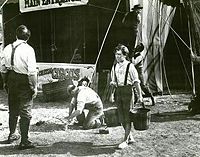
Fortunately Driscoll's second long-run Disney contract allowed him to be loaned to independent Horizon Pictures for the double role of Danny/Josh Reed in When I Grow Up (1951). His casting was the result of the personal suggestion of Oscar-winning screenplay writer Michael Kanin. When I Grow Up was commissioned by producer Sam Spiegel, and was a little low-budget movie shot in less than a month between mid-November and mid-December 1950, basically on a sound stage at California Studios. Although it received decent reviews, the chief complaint was its length. Following its initial run, it disappeared completely, and the financial losses attended by its production costs of approximately half a million dollars plagued Horizon Studios for the next two years.According to Spiegel's biographers, he was disappointed by the manner in which the entire project was handled.[33] The picture proved to be Kanin's only, but unsuccessful directorial effort.
Walt Disney's Christmas Shows and Goofy Jr.
In addition to his brief guest appearance in Walt Disney's very first TV Christmas show in 1950, also known as One Hour in Wonderland, sponsored by the Coca-Cola Company and hosted by Kathryn Beaumont,[34] his later co-star in 1953's animated Peter Pan, and being featured in this very role in a second such recorded promotion show on Christmas of 1951, [35][36] Driscoll lent his voice to Goofy, Jr. in the Disney cartoon shorts, Fathers are People and Father's Lion, which were released in 1951 and '52, respectively.
The Happy Time

In 1952, Driscoll also portrayed Robert "Bibi" Bonnard in Richard Fleischer's comedy The Happy Time (1952), which was based on a Broadway play of the same name by Samuel A. Taylor. Cast with acting veterans Charles Boyer, Marsha Hunt, Louis Jordan, and Kurt Kasznar, he played the juvenile offspring of a patriarch in Quebec of the 1920s. On the cusp of adolescence and callow concerning matters of love, Bibi was the character upon whom the plot actually centered. Shot in about one month's time during January–February 1952, the movie was so well done that it became a considerable success for producer Stanley Kramer and director Richard Fleischer,[37] who, just two years later, would score with the Walt Disney Fantasy classic 20,000 Leagues Under the Sea, starring Kirk Douglas, James Mason, and Peter Lorre.
Peter Pan
The Happy Time was released in December 1952, when Driscoll’s last major success, Peter Pan, was already in the can, since it was largely produced between May 1949 and mid-1951,[38] although first preparatory works and story developments started in the late 1930s and early 1940s already. Only the United State's entry into World War II stopped all further works on the project in order to focus on the production of war films for the government.[39]
When work resumed in May 1949, opposite Disney's "Little British Lady" Kathryn Beaumont, who was cast in the role of Wendy Darling, (and who was also the live action model and voice of his 1951 Alice in Wonderland), he was used as the reference model for the close-ups and Peter Pan's voice, while dancer and choreographer Roland Dupree was the actual live-action model for the title character. [40][41] Scenes were played on an almost empty sound stage with only the most essential props, and filmed for use by the illustrators. Animation takes a long time, and production of Peter Pan was in fact so protracted that even Hans Conried, who played and voiced Captain Hook (and Mr. Darling) was allowed to do some other screen work between his services on the project.[42]
Decline
"Dropped"
As Driscoll grew older, he began to drift further and further away from Walt Disney's generally known personal conception of what epitomized a child star. In his biography on Disney Marc Elliot described him as the producer's favorite "life action" child star.
In additional words: "Walt often referred to Driscoll with great affection as the living embodiment of his own youth [...]"[43]
However, during a project meeting following the completion of Peter Pan, Disney now stated that he fancied the boy as a juvenile screen bully rather than the characters he had portrayed on the screen and which had leveraged him to stardom. Not only biographers, such as Leonard Mosley and Marc Elliot, but studio authorities, employees and directors (such as Byron Haskin and Richard Fleischer) as well, agreed in their memories that there was nothing that Walt Disney detested more than having costly, but unemployed workers on his payroll and compared to his salary, Driscoll had quite little to work from 1952 on. But Disney of all the people had been the one, who, still in February 1949, had issued the then twelve-years-old a two-years extension of his 1948 five-years contract, now running until 1956 and raising the boy's salary to $1750 per week, up from the $1250 weekly figure called for by the contract of the previous year.[44]
In early 1953 then, this internal matter called for a definitive decision, resulting in a dropping of this additional two-year option in late March 1953, [45] just weeks after Peter Pan was released theatrically. An additional severe case of acne, accompanying the onset of his puberty[46] and explaining why it was necessary for Driscoll to use heavy makeup for his performances on dozens of TV shows, was officially provided as the final reason for the determination of his connection with the Disney Studios.
TV and radio
Cut loose from Disney and now well into in his adolescent years, Driscoll encountered increasing indifference from the other Hollywood studios. Still perceived as "Disney’s kid actor" [47] it was almost impossible for him to meet the image of a serious character actor and when no new offers appeared that would bring him back to the movie screen, he became more and more dispirited. Beginning in 1953 and for most of the next three years, the bulk of his work was confined to television on such anthology and drama series as Fireside Theatre, Schlitz Playhouse of Stars, Front Row Center, Navy Log, TV Reader's Digest, Climax!, Ford Theatre, Studio One, Dragnet, Medic, and Dick Powell's Zane Grey Theater. In some special star focusing series, he even enjoyed co-starring roles with such acting notables as Loretta Young, Gloria Swanson, and Jane Wyman.
Between 1948 and 1957, he also performed on a number of radio productions, which even included a special broadcast version of Treasure Island in January 1951 and of Peter Pan in December 1953. And as it was common practice in this business, Driscoll and his child partner Luana Patten did promotional radio gigs (starting in late 1946 for Song of the South) and toured the country on various parades and charity events through the years.[48]
In 1947, he already recorded a special version of "So Dear to My Heart" at Capitol Records.[49]His reward for all of that would be in 1954 a Milky Way Gold Star Award, chosen in a nationwide poll for his work on television and radio.[50]
"Washed up"
After leaving the Disney studios, Driscoll's parents decided to withdraw their son from the talent supporting Hollywood Professional School,[51][52][53][54] which he had previously attended, and sent him to the public Westwood University High School instead. A substantial mistake, as his mother later would admit to a reporter, because there, he not only dropped from a straight A-student to an average pupil, but his former stardom additionally became more burden than advantage. Being ridiculed was commonplace, and he, as a former and now washed-up Disney star, was constantly made the target of the cruel remarks and barbs of jealous fellow students. Wishing only to gain acceptance in his new surroundings, he likely sought those outside the school's inner circle, which may have led him to his first experimentation with drugs in a desperate attempt at securing a place among his peers.[55][56]
One of his most famous quotations from that time is: The other kids didn't accept me. They treated me as one apart. I tried desperately to be one of the gang. When they rejected me, I fought back, became belligerent and cocky — and was afraid all the time.[57][58]
When the pressure and malice from his school-mates grew too hard to stay at this public school any longer, at his own request Driscoll returned just one year later to Hollywood Professional School, where in May 1955 he finally graduated.[59] However, the damage was done. In no time he was hooked on narcotics, and growing ever more dependent on them, he turned mainly to heroin. His still healthy bank account provided an almost automatic pipeline of cash to the pushers.
At a future interview, years later, he would admit: I was 17 when I first experimented with the stuff. In no time I was using whatever was available, ... mostly heroin, because I had the money to pay for it. [60]
In 1956, Driscoll was arrested for the first time for possession of marijuana. The charge was later dismissed.[61] On July 24, 1956, Hedda Hopper wrote in the Los Angeles Times: "This could cost this fine lad and good actor his career."[62]
This incident had a deep impact on Driscoll's career. Television producers now disapproved of him to such an extent that, in 1957, he could gain just one television part: the loyal brother of a criminal immigrant in M Squad, a long-running crime series which starred Lee Marvin.
In December 1956, Driscoll and his girlfriend, Marilyn Jean Rush, (occasionally misspelled as "Brush") eloped to Mexico to be married. This furtiveness was necessary because they knew that both sets of parents would strenuously object to the marriage. The couple was later re-wed in a Los Angeles ceremony that took place in March 1957.[63] Three children resulted from the union, which culminated, first, in a separation, and finally in a 1960 divorce.[64]
Final roles and end of career
The Scarlet Coat and The Party Crashers
Now electing to use his birth name of "Robert" [65] in another attempt to distance himself from the youngish-sounding "Bobby," (since 1951, among his friends and family already, he preferred to be called "Bob" rather than "Bobby" [66], and in Schlitz Playhouse of Stars - Early Space Conquerors, 1952, he is even credited with "Bob Driscoll"[67]), he managed to land two final screen roles, even in spite of the negative headlines, which would follow from 1956 on. In the first, he was featured with Cornell Wilde in the 1955 release entitled The Scarlet Coat, and in the second, he performed opposite Mark Damon and Connie Stevens in The Party Crashers (1958).[68]
Thereafter, his life became more and more a roller coaster ride, one which included several additional encounters with the law. One of them was, for instance, being charged for disturbing the peace and assault with a deadly weapon, when he hit one of two hecklers, who made insulting remarks with a pistol, while he was washing a girlfriend’s car. After paying of a bail the charge was dropped. [69] Yet, that all ultimately led to his eventual sentencing late in 1961 as a drug addict and his imprisonment at the Narcotic Rehabilitation Center of the California Institution for Men in Chino, California. His very last known appearances on TV were small roles in two, single-season series: The Best of the Post, a syndicated anthology series adapted from stories published in The Saturday Evening Post magazine, and The Brothers Brennagan, an unsuccessful crime series. Both were originally aired on November 5, 1960.
When Driscoll left Chino in early 1962, clean and eager to make a comeback, he was now ignored by the industry that once had raised and nurtured him, solely because of his record as a convict and former drug addict. Embittered by his treatment by Hollywood, he said:"I have found that memories are not very useful. I was carried on a silver platter ... and then dumped into the garbage can" [70]
New York City and death
In 1965, scarcely one year after his parole expired, he relocated to New York, hoping to revive his career on the Broadway stage, but only to find that his reputation had preceded him and no one wanted to hire him there, either.[71]
He became part of Andy Warhol's Greenwich Village art community, also known as The Factory,[72] where he began focusing on his artistic talents. He had previously been encouraged to do so by famed artist and poet Wallace Berman, whom he had befriended after joining Berman's art circle (also known as Semina Culture) in Los Angeles in 1956. Some of his works were considered outstanding,[73][74] and a few of his surviving collages and cardboard mailers were temporarily exhibited in Los Angeles at the Santa Monica Museum of Art.[75][76] And it was also in 1965, early on in his tenure at The Factory, that Driscoll gave his last known performance, that being in experimental filmmaker Piero Heliczer's Underground movie Dirt.[77]
The only information known about the last months of Driscoll's life is that he left Andy Warhol's entourage and The Factory in late 1967 or very early 1968 and, completely penniless and disillusioned, disappeared into Manhattan's underground. On March 30, 1968, about three weeks after his 31st birthday, two boys playing in a deserted East Village tenement on East 10th St found his dead body. The medical examination determined that he had died from heart failure caused by an advanced hardening of the arteries [78] due to longtime drug abuse. There was no ID on the body, and photos taken of it and shown around the neighborhood yielded no positive identification.
When Driscoll's body went unclaimed and was believed to be that of a homeless person, he was buried in an unmarked pauper's grave in New York City's Potter's Field on Hart Island. [79][80]
Late in 1969, about nineteen months after his demise, Driscoll's mother sought the help of officials at the Disney studios in a desperate attempt to contact him for a hoped-for reunion with his father, who was near death. This eventually resulted in a fingerprint match at NYPD, which located him on Hart Island. Although his name appears on his father's gravestone at Eternal Hills Memorial Park in Oceanside, it is merely a cenotaph[81] since his remains still rest on Hart Island.
Bobby Driscoll's death was not publicly acknowledged until the re-release of his first Disney film, Song of the South, in 1971/72, when reporters decided to research the whereabouts of the film's major cast members. It was through an interview with his mother that they learned the facts about his short life and early death.[82]
Tribute
In February 2009 singer and songwriter Benjy Ferree released Come Back to the Five and Dime Bobby Dee Bobby Dee - a concept album about Driscoll's life and tragic death.[83]
Footnotes
- ↑ "Famous Iowans". Des Moines Register
- ↑ Peregrine, Peggy. Studio Round-Up meets Bobby Driscoll, Picturegoer, 1949-11-19. Retrieved on 2008-09-02.
- ↑ Cini, Zelda. Hot-Rod Stage Shares Affections of Bobby Driscoll, Hollywood Studio Magazine, 1977-03, pp. 12. Retrieved on 2008-10-21.
- ↑ LOST ANGEL - Bobby's very first film role. www.bobbydriscoll.net. Retrieved on 2008-09-02.
- ↑ Youthful Find Signed By 20th Century Fox, Los Angeles Times, 1944-02-05. Retrieved on 2008-09-02.
- ↑ Schallert, Edwin. SO GOES MY LOVE - Engaging Trumpery, Los Angeles Times, 1946-05-24. Retrieved on 2008-09-02.
- ↑ www.songofthesouth.net - Official Homepage. Retrieved on 2008-09-02.
- ↑ Parsons, Luella. That Little Girl in 'Song of the South' a Big Girl Now, Lincoln Sunday Journal and Star, 1960-02-28. Retrieved on 2008-09-02.
- ↑ Walt's "Sweetheart Team", Lincoln Sunday Journal and Star, 1946-11-10. Retrieved on 2008-09-02.
- ↑ SO DEAR TO MY HEART - actual production dates. http://tcm.com. Retrieved on 2008-10-17.
- ↑ THE WINDOW - A Fansite. Retrieved on 2008-09-02.
- ↑ Baby Oscar For Young Star, The Daily Courier, Conellesville (Pennsylvania), 1950-03-31. Retrieved on 2008-09-02. , Winners Of Honors Named, The News, Frederick (Maryland), 1950-03-24. Retrieved on 2008-09-02.
- ↑ Oscar-Winners and Nominees of 1949. Retrieved on 2008-09-02.
- ↑ (East) Harlem, New York. New York City Map. Retrieved on 2008-09-02.
- ↑ RKO-Pathé, New York, Harlem - correct Address. Retrieved on 2008-09-02.
- ↑ THE WINDOW - Production details. Turner Classic Movies. Retrieved on 2008-09-02.
- ↑ Scheuer, Phillip K.. Cameraman Tetzlaff Scores as Director, The Los Angeles Times, 1948-10-24. Retrieved on 2008-09-02. , Film Faking Takes Some Ingenuity, Mansfield News Journal (Ohio), 1950-03-24. Retrieved on 2008-09-02.
- ↑ THE WINDOW - Notes. Turner Classic Movies. Retrieved on 2008-09-02.
- ↑ The Window, "Depicting Terror of Boy in Fear of His Life [...], The New York Times (via www.nytimes.com), 1949-08-08. Retrieved on 2008-11-16.
- ↑ Margaret Kerry - Official Homepage. Archived from the original on 2007-12-18. Retrieved on 2008-09-02.
- ↑ A comprehensive Interview with Margaret Kerry (especially on her memories while working at the Disney Studios). Ultimated Disney. Retrieved on 2008-09-02.
- ↑ Melody Time. www.bobbydriscoll.net. Retrieved on 2008-09-02.
- ↑ Walt Disney Organizing Trek to England, Los Angeles Times, 1949-04-15. Retrieved on 2008-09-02. , Scott, John L.. Disney's New Feature High in Values, Los Angeles Times, 1949-02-23. Retrieved on 2008-09-02. , Disney Animated Flood of Film Including All-Live "Treasure Island", Los Angeles Times, 1949-06-15. Retrieved on 2008-09-02. , Treasure Island With Bobby Driscoll and Robert Newton at "The Mayfair", New York Times, 1950-08-16. Retrieved on 2008-09-02.
- ↑ British Court Upholds Bobby Driscoll Fine, unknown, 1949-10. Retrieved on 2008-09-02. , Adamson, Joe (1984). Byron Haskin, interviewed by. Metuchen, N.Y. and London: The Director's Guild of America and The Scarecrow Press, Inc., 174-175. ISBN 0-8108-1740-3.
- ↑ Adamson, Joe (1984). Byron Haskin - interviewed by .... Metuchen, N.Y. and London: The Director's Guild Of America and The Scarecrow Press, Inc., pages 174-175. ISBN ISBN 0-8108-1740-3.
- ↑ Adamson, Joe (1984). Byron Haskin - interviewed by .... Metuchen, N.Y. and London: The Director's Guild Of America and The Scarecrow Press, Inc., page 168. ISBN ISBN 0-8108-1740-3.
- ↑ Tom Sawyer, Los Angeles Times, 1950-06-07. Retrieved on 2008-09-02.
- ↑ Adamson, Joe (1984). Byron Haskin - interviewed by .... Metuchen, N.Y. and London: The Director's Guild Of America and The Scarecrow Press, Inc., page 168. ISBN ISBN 0-8108-1740-3.
- ↑ Adamson, Joe (1984). Byron Haskin - interviewed by .... Metuchen, N.Y. and London: The Director's Guild Of America and The Scarecrow Press, Inc., page 168. ISBN ISBN 0-8108-1740-3.
- ↑ Walt Disney Will Follow Up 'Treasure Island', Los Angeles Times, 1950-01-18. Retrieved on 2008-09-02. , Schallert, Edwin. Disney Again to Wed Cartoons, Live Action, Los Angeles Times, 1950-07-22. Retrieved on 2008-09-02. , Hopper, Hedda. Robert Néwton to Portay Friar Tuck, Los Angeles Times, 1951-02-21. Retrieved on 2008-09-02.
- ↑ Bobby Driscoll Says Farewell', Film Illustrated Monthly (paragraph: "Watch Out For These"), 1950-November. Retrieved on 2009-06-09.
- ↑ The Story of Robin Hood and His Merrie Men (1952). American Film Institute. Retrieved on 3 October 2013.
- ↑ Fraser-Cavassoni,, Natasha (2003). Sam Spiegel - The Incredible Life and Times of Hollywood's Most Iconoclastic Producer [...]. New York, London, Toronto, Sydney, Singapore: Simon & Schuster, pages 119-20. ISBN ISBN 0-684-83619-X.
- ↑ One Hour In Wonderland. www.bobbydriscoll.net. Retrieved on 2008-09-02.
- ↑ The First Disney Television Christmas - Wade Sampson on Walt Disney#s first TV Christmas shows. Retrieved on 2009-01-05.
- ↑ Driscoll, Bobby. Personal Letter (to his girl friend, in which he describes the content/nature of Walt Disney's second Christmas show, The Park Sheraton Hotel, New York City, 1951-11-30. Retrieved on 2008-09-02.
- ↑ Fleischer, Richard (1993). Richard Fleischer - Just Tell Me When To Cry - a Memoir. New York: Carroll & Graf Publishers, Inc., pages 80-83. ISBN ISBN 0-881-84944-8.
- ↑ PETER PAN - actual production data. Turner Classic Movies (Official Homepage). Retrieved on 2008-09-02.
- ↑ PETER PAN - actual production data. Turner Classic Movies (Official Homepage) - section: Notes. Retrieved on 2008-09-02.
- ↑ About us (Biography). www.dupreeexpo.com (Official Homepage of Roland Dupree). Retrieved on 2008-09-02.
- ↑ Memorabilia & Collectibles (signed production photographs with detailed captions. Tinker Bell Talks - Official Homepage of Margaret Kerry (Tinker Bell). Retrieved on 2008-09-02.
- ↑ Cargiulo, Suzanne; Leonard Maltin (Foreword) (2002). Hans Conried - a Biography; with a Filmography and a Listing of Radio, Television, Stage and Voice Work. Jefferson, North Carolina and London: Mcfarland & Company, Inc., pages 78-79. ISBN ISBN 0-7864-1338-7.
- ↑ Elliot, Marc (1993, 1994, 1995). Walt Disney - Hollywood's Dark Prince - A Biography. London: Andre Deutsch (publisher) Ltd., First (UK) Paperback edition, 203. ISBN ISBN 0-233-98961-7.
- ↑ $300-A-Week Smile - There Is a Film Santa, Syracuse Herald Journal, 1946-02-22. Retrieved on 2008-09-02. , $400-A-Week, Reno Evening Gazette, 1947-02-14. Retrieved on 2008-09-02. , New Contract For Boy Film Actor Approved, unknown, 1949-02. Retrieved on 2008-09-02.
- ↑ Johnny Crawford in an interview on his career - and the common practice at The Disney Studios - (subtitle: How and why did you leave the "Mickey Mouse Club"?). Retrieved on 2009-01-02.
- ↑ Berch Jamison, Barbara. The Dangerous Years, Motion Picture And Television Magazine, April 1953, pp. 47,84. Retrieved on 2008-09-02.
- ↑ A Tribute to Shirley Booth, paragraph: Dean Martin on Shirley Booth - Dean Martin recalling an encounter with Driscoll at a party in the mid-1950s, literally terming him ... that Disney kid actor .... Retrieved on 2008-12-26.
- ↑ Flower Classes Open Tomorrow, Los Angeles Times, 1948-01-11. Retrieved on 2008-09-02. , Hopper, Hedda. Santa Claus Lane Parad, Los Angeles Times, 1950-11-28. Retrieved on 2008-09-02. , Block-long Flag to Mark Dimes Parade, Los Angeles Times, 1952-01-18. Retrieved on 2008-09-02. , Back-To-School Show, Los Angeles Times, 1950-08-24. Retrieved on 2008-09-02. ,
- ↑ Bobby On Air. www.bobbydriscoll.net. Retrieved on 2008-09-02.
- ↑ Radio-TV Youth Win Top Awards, Los Angeles Times, 1954-03-18. Retrieved on 2008-09-02.
- ↑ Mosby, Aline. Pupils In Hollywood School Drew More pay Than Their Teachers, The Coshocton Tribune (Ohio), 1956-02-19. Retrieved on 2008-09-02. , Mosby, Aline. Strangest Grammar School In Nation Found In Hollywood, The Daily Courier, Cornellsville (Pennsylvania), 1956-02-18. Retrieved on 2008-09-02.
- ↑ Hollywood Professional School. Retrieved on 2008-09-02.
- ↑ Hollywood Professional School. Rock and Roll Roadmaps. Retrieved on 14 November 2013.
- ↑ Hollywood Professional School. Seeing Stars. Retrieved on 2008-09-02.
- ↑ Berch Jamison, Barbara. The Dangerous Years, Motion Picture And Television Magazine, April 1953, pp. 47, 84. Retrieved on 2008-09-02.
- ↑ Epstein, Barbara. The Lonely Death Of a Star, Movie Digest, July 1972, pp. 104. Retrieved on 2008-09-02.
- ↑ Little Discipline, Violette Messenger, Valparaiso (Indiana), 1958-05-27. Retrieved on 2008-09-02.
- ↑ Epstein, Barbara. The Lonely Death of a Star, Movie Digest, July 1972, pp. 100-107. Retrieved on 2008-09-02.
- ↑ Bobby's graduation at Hollywood Professional School. www.bobbydriscoll.net. Retrieved on 2008-09-02.
- ↑ The Long Road Back – Bobby Driscoll, a Film Star at 6, an Addict at 17, Sent to Chino, The Los Angeles Times, 1961-10-19. Retrieved on 2008-11-19.
- ↑ Bobby Driscoll, Friend Denies Narcotic Charge - This Is No Act, Los Angeles Times, 1956-07-12. Retrieved on 2008-09-02. , Hopper, Hedda. Serious Matter, Los Angeles Times, 1956-07-24. Retrieved on 2008-09-02. , Actor Bobby Driscoll, 19, Seized On Dope Charge, Los Angeles Times, 1956-07-11. Retrieved on 2008-09-02. , Narcotic Charge Dismissed, Reno Evening Gazette, 1956-07-17. Retrieved on 2008-09-02.
- ↑ Hopper, Hedda. Serious Matter, Los Angeles Times, 1956-07-24. Retrieved on 2008-09-02.
- ↑ Actor Driscoll reveals To Plan To Rewed Girl, 19, Los Angeles Times, 1957-03-09. Retrieved on 2008-09-02. , Actor Driscoll Needs Job As Clerk To Finance Marriage, Newport Daily News (Rhode Island), 1957-03-09. Retrieved on 2008-09-02.
- ↑ The Long Road back - Bobby Driscoll, a Film Star At 6, An Addict At 17, Sent To Chino, Los Angeles Time, 1961-10-19. Retrieved on 2008-09-02.
- ↑ Thomas, Bob. Hollywood ..., Violette Messenger, Valparaiso (Indiana), 1958-05-27. Retrieved on 2008-09-02.
- ↑ Driscoll, Bobby. A personal Letter to his girl friend of then, which he closes with "Bob".), The Park Sheraton Hotel, New York City, 1951-11-30. Retrieved on 2008-09-02.
- ↑ Schlitz Playhouse of Stars: Early Space Conqueror (Season 1 Episode 42). TV.com. Retrieved on 3 October 2013.
- ↑ Thomas, Bob. Bobby Driscoll Hopes To Rebuild Film Life, Violette Messenger, Valparaiso (Indiana), 1958-05-27. Retrieved on 2008-09-02. , Actors Seem More Intent, State Stars, Van Nuys News (California), 1958-08-21. Retrieved on 2008-09-02.
- ↑ Bobby Driscoll pleads guilty, Indiana Evening Gazette, 1960-10-19. Retrieved on 2008-11-18. Ex-Child Acztor Cleared in Court, Indiana Evening Gazette, 1960-10-24. Retrieved on 2008-11-18. Bobby Driscoll Freed On Bail After Fracas, Los Angeles Times, 1960-06-19. Retrieved on 2008-11-18.
- ↑ Bobby Driscoll Won't Be Around For Reissue Of "Song Of The South" (last column), Los Angeles Times, 1972-02-13. Retrieved on 2008-11-16.
- ↑ His mother on his downslide. The Lonely Death Of A Star (on www.bobbydriscoll.net). Movie Digest (July 1972). Retrieved on 2008-09-02.
- ↑ Bobby Driscoll sitting on a couch (on portfolio, page 38, third row - it's the last known photograph of him, ca. late) 1967. OvoWorks, New York City - Official Homepage. Retrieved on 2008-09-02.
- ↑ SEMINA CULTURE - Wallace Berman & His Circle. Umbrella Exhibition Catalogue, vol. 28, no.2-3 (October 2005). Retrieved on 2008-09-02.
- ↑ A Return Trip to a Faraway Place Called Underground. The New York Times online (1972-01-26). Retrieved on 2008-09-02.
- ↑ Santa Monica Museum Of Art - Official Homepage. Retrieved on 2008-09-02.
- ↑ Duncan, Michael; McKenna, Christine (2005). SEMINA CULTURE - Wallace Berman & His Circle. Los Angeles: Santa Monica Museum Of Art, 132-135, 233.
- ↑ DIRT- Review and a downloadable clip of the so-called "Bath-sequence". Retrieved on 2008-09-02.
- ↑ The cause of his death. www.bobbydriscoll.net. Retrieved on 2008-09-02.
- ↑ Hart Island (Potter's Field) - Official Homepage (controlled by the "Department Of Correction" and with that inaccessable to visitors). Retrieved on 2008-09-02.
- ↑ The Hart Island Project. Retrieved on 2008-09-02.
- ↑ Bobby Driscoll's page. Find A Grave. Retrieved on 2008-09-02.
- ↑ Beck, Marylin. With Re-Release Of Disney Film - Child Star's Tragic Death Described, The Lima News (California), 1971-07-14. Retrieved on 2008-09-02. , Larson, Donna. Bobby Driscoll Won't Be Around For Reissue Of Song of the South, Los Angeles Times, 1972-02-13. Retrieved on 2008-09-02. , Epstein, Barbara. The Lonely Death Of a Star, Movie Digest, July 1972, pp. 98-107. Retrieved on 2008-09-02.
- ↑ Benjy Ferree - Come Back To The Five and Dime. Retrieved on 2009-01-01. Benjy Ferree Announces New Album, Channels Former Child Star Bobby Driscoll. Retrieved on 2009-01-01.


